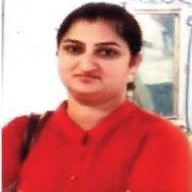
Asha Kannur
Work place: Matrihita Edtech Vijayapura, 586103, India
E-mail: asha.kannur31@gmail.com
Website: https://orcid.org/0000-0002-6475-822X
Research Interests: Artificial Intelligence
Biography
Asha Kannur is working as Entrepreneur and Educationalist of Matrihita EdTech LLP, Vijayapur. She is having 15 years’ experience in teaching and currently she is entrepreneur of Matrihita Edtech LLP. She completed her M.Tech. in Digital Electronics in the year 2007 and B.E. in Electrical & Electronics Engineering in the year 2004. Her active research areas are Artificial Intelligence and Microcontroller, she has taught many courses for UG and PG students and guided UG projects. She has about 3 Publication in peer-reviewed international journals and refereed conferences such as Scopus, SCI etc. and 1 Patent. She has conducted various workshops, seminars, symposium in colleges.
Author Articles
A Hierarchical Support Vector Machines for Weapons Identification Using Multiple Stabbed Wound Images
DOI: https://doi.org/10.5815/ijigsp.2022.06.07, Pub. Date: 8 Dec. 2022
This paper proposes hierarchical support vector machines for weapon Identification using images of repeated stab wound patterns caused by sharp metal weapons used in homicidal cases and also presents a comparative study with standard flat support vector machine. The methodology includes the segmentation technique for the extraction of region-of-interest in the image using transition region-based segmentation algorithm and then texture, shape and size features were extracted from the segmented image. For multiple classes, a hierarchical support vector machine is adapted as a classifier. This approach gives a computationally interesting and efficient alternative solution to identify the weapons used in the crime; this method uses the digital images of repeated stab wound patterns which appear on the human body. The experimental study has three main stages, at the first stage includes generating of non-overlapping segments from the pattern, at the second stage the features of wound patterns are extracted and finally identification of patterns and its weapon of cause. The proposed method accuracy assessment is performed and also comparison study is performed with standard flat support vector machine and with the traditional method of forensic pathology. The experimental results achieved for Identification is 96.71% accuracy, with an available database of 500 images of a pattern consisting of repeated stabbed wounds. From the comparative study, the proposed methodology has given better results than standard SVM and traditional method. The proposed method delivers a better solution for identification from the image of the repeated stab wound pattern as there is no human intervention that reduces the error and data manipulation unlike traditional manual method.
[...] Read more.Other Articles
Subscribe to receive issue release notifications and newsletters from MECS Press journals